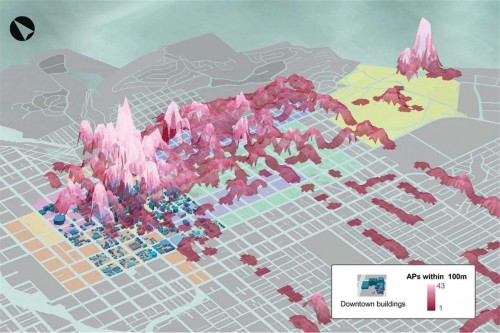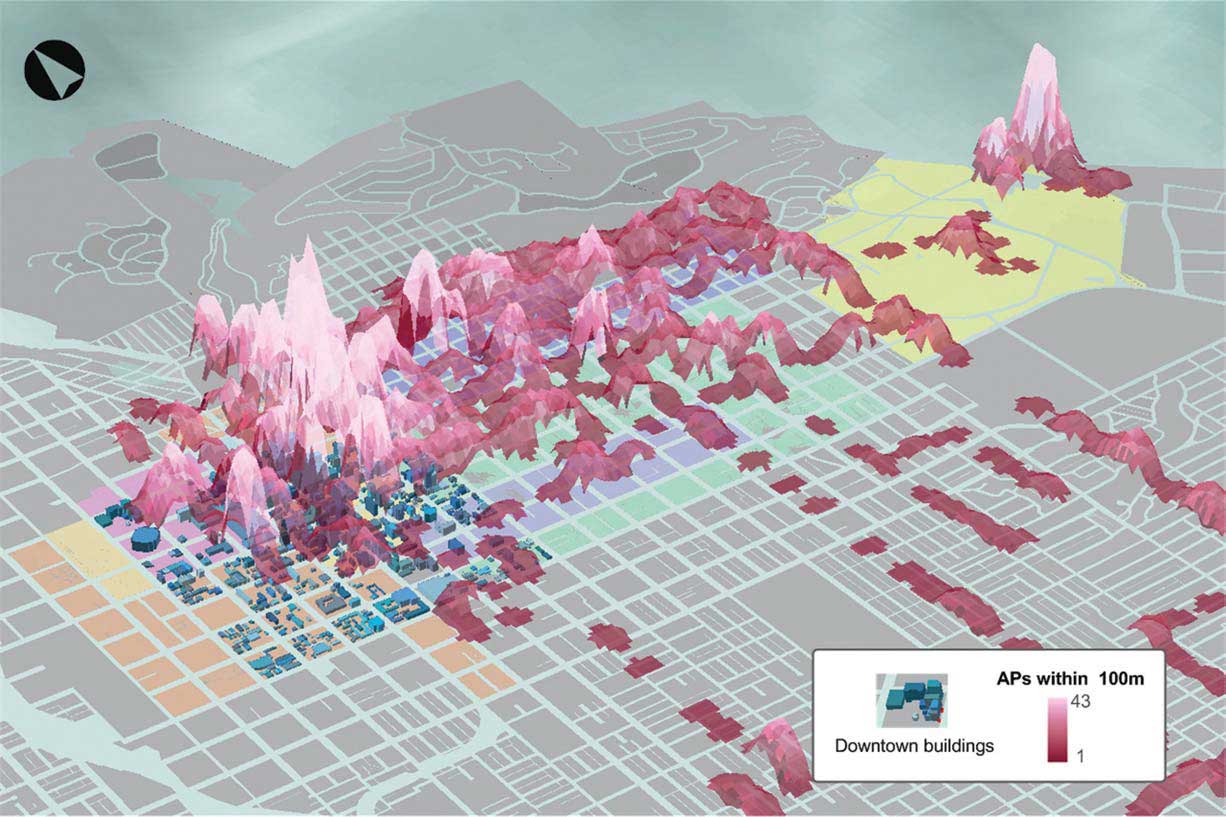[This post is a part of a series covering my qualifying exam research areas. Scroll to the bottom of this post for links to each area, or click here for a general description of the process.]

Description
Phenomenologically speaking, our engagement with new media objects is predominantly spatial. Linearity naturally emerges out of this engagement as we sequence one experience after another, but we begin and transition by “navigating,” “searching,” “scanning,” “browsing,” “downloading,” “visiting,” and any number of other verbs that imply movements across, through, to, from, and around. Further, the increasingly tenuous boundaries between new media objects — where does Google end, and where does the information it indexes begin? — imply a kind of limitless and endlessly reconfigurable hyperspace, one that extends well beyond the confines of the screen and into the hybrid digital/physical spaces that constitute our lived environment. As this mode of engagement becomes dominant, what kinds of changes are we seeing in epistemology, representation, identity, and narrativity? What is newly possible, and what is foreclosed — and for whom? And finally, what are the poetic affordances of this spatiality?
Coming to terms with the many valences of “space” in this context requires a multi-threaded interdisciplinary investigation. The first thread of this investigation looks at space through the lens of twentieth century critical theory and cultural studies (Bachelard, Benjamin, Foucault, Lefebvre, De Certeau). These texts inform an understanding of how space is used as a means of (re-)inscribing and resisting economic and cultural hegemonies; how this use co-constructs, renews, and reshapes meaning; and how these meanings reflect and feed back on the social and economic orders that circumscribe our experience of place. Lurking in the background here are several related spheres of discourse, including intersubjective systems theory; notions of mutualism, multiplicity, and nomadism; and theories of emergence and utopia. The second thread draws on several relatively recent texts examining theories around the phenomenology and epistemology of the spatial modalities inherent in our engagement with new media objects (Aarseth, Hayles, Harrigan and Wardrip-Fruin, Manovich, McPherson, Vesna). The central metaphors of navigation and database found in these works provide crucial context for the final thread of this research focus, which examines a variety of media artifacts and theories that operate within spatialized engagement modalities, beginning with postwar and late twentieth century critical interventions and theories of play (Nieuwenhuys, Debord, Huizinga), following through the ascendance and praxis of transmedia storytelling and distributed narratives (Bleecker, Jenkins, Walker), and concluding with spatial new media story/play systems such as alternate reality games (Dena, Hon, McGonigal, Szulborski), pervasive games (Montoya, de Souza e Silva and Sutko), site-specific art movements (Kwon), and social media games.
Bibliography
Aarseth, Espen J. Cybertext: Perspectives on Ergodic Literature. Johns Hopkins University Press, 2006.
Bachelard, Gaston. The Poetics of Space. Beacon Press, 1994.
Batchen, Geoffrey. “Spectres of Cyberspace,” in Mirzoeff, Nicholas (ed.) The Visual Culture Reader. Routledge, 2002.
Benjamin, Walter. “Paris — Capital of the Nineteenth Century,” Selected Writings, vol 3, 1935-1938. Harvard University Press, 2006.
Bleecker, Julian, Jake Dunagan, Sascha Pohflepp, Stuart Candy, Jennifer Leonard, and Bruce Sterling. “Design Fiction: Props, Prototypes, Predicaments Communicating New Ideas.” Mp3. SXSW 2010. http://my.sxsw.com/events/event/465
Bush, Vannevar. “As We May Think” in Wardrip-Fruin, Noah and Montfort, Nick (ed.) The New Media Reader. MIT Press, 2003.
Certeau, Michel de. The Practice of Everyday Life. University of California Press, 2002.
Dena, Christy. Transmedia Practice: Theorising the Practice of Expressing a Fictional World across Distinct Media and Environments. Doctoral Dissertation, 2009.
Deleuze, Gilles and Guattari, Felix. Thousand Plateaus. Athlone Press, 2000.
Foucault, Michel. “Of Other Spaces,” Diacritics, Spring 1986. 22-27.
Harrigan, Pat and Wardrip-Fruin, Noah. Third Person: Authoring and Exploring Vast Narratives. MIT Press, 2009.
Harvey, David. “The Right to the City.” New Left Review 53, October, 2008. http://www.newleftreview.org/?view=2740
Hayles, N. Katherine. Electronic Literature: New Horizons for the Literary. University of Notre Dame, 2008.
Hon, Dan. “Everything you know about ARGs is WRONG.” http://www.sixtostart.com/onetoread/2008/everything-you-know-about-args-is-wrong/
Huizinga, J. Homo Ludens. Routledge, 2008.
Jenkins, Henry. “Transmedia Storytelling 101,” Confessions of an Aca-Fan, 2007. http://henryjenkins.org/2007/03/transmedia_storytelling_101.html
Knabb, Ken. Situationist International Anthology. Bureau of Public Secrets, 2007.
Kwon, Miwon. One Place After Another: Site-Specific Art and Locational Identity. MIT Press, 2004.
Lefebvre, Henri. The Production of Space. Wiley-Blackwell, 1992.
Manovich, Lev. The Language of New Media. MIT Press, 2001.
McGonigal, Jane. “This Is Not a Game: Immersive Aesthetics and Collective Play,” Proceedings: Digital Arts and Culture 2003, edited by A. Miles. RMIT University, 2003. http://hypertext.rmit.edu.au/dac/papers/McGonigal.pdf
McPherson, Tara. “Reload,” in Mirzoeff, Nicholas (ed.) The Visual Culture Reader. Routledge, 2002.
Souza e Silva, Adriana de and Sutko, Daniel M. Digital Cityscapes: Merging Digital and Urban Playspaces. Peter Lang Publishing, 2009.
Szulborski, Dave. This Is Not A Game: A Guide to Alternate Reality Gaming. New Fiction, 2005.
Vesna, Victoria, ed. Database Aesthetics: Art in the Age of Information Overflow. University of Minnesota Press, 2007.
Walker, Jill. “Distributed Narrative: Telling Stories Across Networks,” AoIR 5.0, September 21, 2004. http://jilltxt.net/txt/Walker-AoIR-3500words.pdf
Wardrip-Fruin, Noah and Montfort, Nick. The New Media Reader. MIT Press, 2003.
Qualifying Exam Areas
- New media spaces [blog archive]
- History and theories of participatory culture and art practice [blog archive]
- Interaction design for social media and pervasive computing [blog archive]
I’ve also written a brief post on the ongoing role that this website is playing in my research:
Finally, you can download the latest version of my exam area descriptions and bibliographies in .pdf form here.
